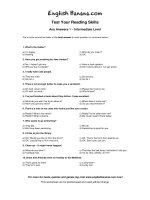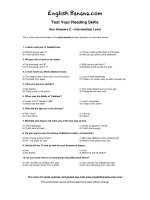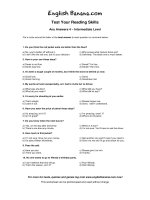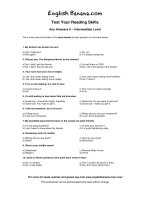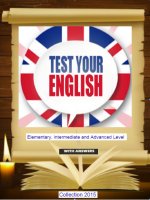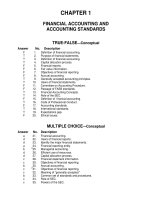Select readings book and quizzes with answers intermediate level
Bạn đang xem bản rút gọn của tài liệu. Xem và tải ngay bản đầy đủ của tài liệu tại đây (17.53 MB, 207 trang )
A-PDF MERGER DEMO
Sefect Readings
OXTORD
\.TNIVERSITY
PRESS
OXFORD
IJNIVERSITY PRESS
198MadisonAvenue,New York, NY 10016USA
Great ClarendonStreet,Oxford OX2 6DP England
Oxford University Pressis a departmentof the
University of Odord. It furthers the University's
objectiveof excellencein research,scholarship,and
education by publishing worldwide in
O>dord NewYork
Auckland Bangkok BuenosAires CapeTown
Chennai Dar es Salaam Delhi Hong Kong
Istanbul Karachi Kolkata Kuala Lumpur
Madrid Melbourne Mexico City Mumbai
Nairobi SaoPaulo Shanghai Singapore
Taipei Tokyo Toronto
with an associatedcompanyin Berlin
OXFORDis a registeredtrademark of Oxford
Universiry Press.
ISBN 0-19-437475-0
Published in the United States by Oxford University
Press,New York
Copfryight@2001Oxford University Press
Library of Congress Cataloging-in-Publication
Data
Lee, Linda, 1950Selectreadingsintermediate/ by Linda Lee and
Erik Gundersen.
p.cm.
rsBN 0-19-437475-0
1. English language-Textbooksfor foreign
speakers.
2. Readers.L Gundersen,Erik. II. Title.
2000
PE1128.L426
00-029125
428.6'4-dc2l
No unauthorized photocopying
All rights reserved.No part of this publication may
be reproduced,stored in a retrieval system,or
transmitted, in any form or by any means,electronic,
mechanical,photocopying,recording, or otherwise,
without the prior written permission of Oxford
University Press.
This book is sold subject to the condition that it shall
not, by way oftrade or otherwise, be lent, resold,
hired out, or otherwise circulated without the
publisher'sprior consentin any form ofbinding or
cover other than that in which it is published and
without a similar condition including this condition
being imposed on the subsequentpurchaser.
Editorial Manager: Chris Foley
DevelopmentalEditor: Chris Balderston
Project Editor: Mary C. D'Apice
Production Editor: Maura Tl,rkey
Contributing Editor: Paul Maclnt''re
Photo Researcher:MauraT\rkey
Designer: SusanBrorein
Cover Design:Tom Hawley,Hawley Design
Production Controller: ShantaPersaud
Production and PrepressServices: Compset,Inc.
Printing (Iast digit): 10 I 8 7 6
Printed in Hong Kong.
ACKNOWLEDGEMENTS
Illustration by.' Glenn Harrington
The publishers would like to thank the
following for their permission to reprod'uce
photog ro,phs: CNP/Archive Photos, FYank
Capri/SAGA,/ArchivePhotos, Boston Globe,
@Bettrnaru/CORBIS,Mike Brinson/The Image Bank
1999,SungChihhsiung, Ghislain and Marie David de
LossylThe Image Bank 1999,China Tourism Press/
YangLiulThe ImageBank 1999,01993 BiII McDowell,
Christie's lmageVSuperStock,Tom RosenthaV
SuperStock,Frank Sitemar/@TonyStonelmages.
The publishers would also like to thank the
follawing for their permission to reprod'uce text
excerpts:
"A Long Walk Home" provided courtesy of the
author, Jason Bocarro
"Getting Readyfor the Message"from Yotn College
Erperience, Expanded Read'erEd,i,tion, 3' Ed'i'tion, by
J.N. Gardnerand A.J.Jewler @1997.Reprintedwith
permission of Wadsworth, a division of Thomson
Learning. Fax 800 730-2215
"Culture Shock" courtesy of the author, Bob
Weinstein.
"A YoungBlind Whiz on ComputersMakes a Name in
WaLIStreet
Industry" provided courtesy of T'LLz
Jout'nal and the Copyright ClearanceCenter.
"Pop Group Enigma'sUse^ofTaiwan Folk SongStirs
Debate" O copyright news report by
NPR'sFrank Koller was originally broadcast on
onJune 11,1999,
NPR's"AlIThings Considered@"
and is used with the permission of National Public
Radio,Inc. Any unauthorized duplication is strictly
prohibited.
"The Enigma Archives" courtesy of Gavin Stok
"How to Make a Speech"by GeorgePlimpton, from
How to Use the Potner oJ the PrLnted Word edltedby
Billings S. Fuess,copy'rdghtO 1985by International
PaperCompany.Used by permissionof Doubleday,a
division ofRandom House,Inc.
"Private Lives" courtesy ofthe author, Diane Daniel.
Interview with BiJl Gates,pp.78-85 fromFzture Talk
by Larry King. Copy'right 1998by Larry King. Reprinted
by permission of HarperOollins Publishers, Inc.
"Letters ofApplication" from Busi'nessLetters the
Easy Wayby AndreaB. Geffner.
"Before, During and After a Job Interview" provided
courtesy ofthe author, PeggySchmidt.
"Out to Lunch" provided courtesy ofJoe Robinson
and ESCAPEMagazine,www.escapemag.com
"Public Attitudes Toward Science"from Black Holes
and BabE Uni,uersesand,Other EssaEsby Stephen
W. Hawking. Copyright @ 1993by StephenW.
Hawking. Used by permission of Bantam Books, a
division ofRandom House,lnc.
"John'sTaiwaneseWedding"provided courtesy of the
authors John FeIW and BilI McDowell.
"Thinking Like a Genius"originally appearedin May
1998issue of TheFuturisl Used with permission
from the World Future Society,7910Woodmont
Avenue,Suite 450,Bethesda,Maryland 20814.
30U656-8274. ht@://www.wfs. org
"ConversationalBalI Games"provided courtesy of
the author, Nancy Sakamoto.
Acknowledgments
The publisher would like to thank the following teachers whose comments, reviews
and assistance were instrumental in the development of Select Readings:
Ann Mei-Yu Chang
Ann-Marie Hadzima
Beatrice Hsiao-Tsui Yang
Brett Reynolds
Chia-Yi Sun
Chi-Fan Lin
Ching-Kang Liu
Christine Chen-Ju Chen
Chuan-Ta Chao
Colin Gullbery
David WY. Dai
Douglas I-Ping Ho
Florence Yi-Hui Chiou
Fujiko Sano
Hsiu-Chieh Chen
Hyung-Gu Lee
Jessica Hsin-Hwa Chen
Jong-Bok Kim
Joyce Yu-Hua Lee
KabyongPark
Kun-liang Chuang
Lee Hyun Woo
Maggie Sokolik
Maureen Chiu-Yu Tseng
Meredith Pike-Baky
Moasung Lin
Monica Li-Feng Kuo
Patricia Pei-Chun Che
Paul Cameron
Pei-Yin Lu
Peng-Hsiang Chen
Richard Solomons
Robin Cheng-Hsing Tsai
Sherry Hsin-Ying Li
Stella Wen-Hui Li
Susan Shu-Hua Chou
Tsuh-Lai Huang
Won Park
Ying-Chien Chang
Yu-Chen Hsu
YunJongRyol
The authors would like to thank the following OUP staff for their support and
assistance in the development of Select Readi,ngs:
Julia Chang
Tina Chen
Coco Cheng
Ted Yoshioka
JJ Lee
Chang Oh Lim
Hyrrn Jeong Lee
Hyun Joo Kim
Paul Riley
Sumio Takiguchi
Toshiki Matsuda
Alison Kane
Aya iwamura
Ally McPhee
Ken Kamoshita
Tim Cupp
Mari Muramatsu
Special thanks to Chris Foley, Chris Balderston, Mary D'Apice, Paul Maclntyre,
and Maura Tirkey for all of your insights, guidance, and suggestions for change
throughout the editorial process. Working with you has been a great pleasure.
Heartfelt thanks to Peter, Jimmy, and Diane for all of your encouragement, support,
Gundersen.
and love-Erik
. iii
Contents
e and Sequence
aiii
trodaction
Chapter I
ai
ALong Walk Home
2
"I had,Iet my father down, and I was about to
Leanuone of the most painful lessons of my life."
Chapter 2 StudentLearningTeams
12
"Rece'ntintetaiews ui,th collegestudents at
Haraard Uniaersi,ty reuealed that nearly euerE
seni,or who had beenpart of a study group
considered this erperience craci,al to his or her
academi,cs'u,ccess."
Chapter 3 CultureShock
2+
"Like the thousands of exchange students who
enroll in American collegeseach year, Tama,ra
Blackmore discouered there is a sea of differerrce
betwee:nreadi,ng about and erpedencing America
firsthand,."
Chapter + A YoungBlindWhiz
36
"Tilr,oughhe is only 18 years old and bli,nd,
Suleyman'i,s a,mong the top conxputer
prograrnnxers at Inteli,Data Technologi,esCoryt., a
La,rge American sofhn are company. "
Chapter 5 Pop Group5Useof FolkSongStirsDebate
+6
"For a si,nger of traditi,onal mus'irc,haai,ng your
uoice on a hit record does not necessarilE make
aou ana nxorleg."
Chapter 6
How to Makea Speech
"Sca,ryas it is, i,t's importantfor anAone to be able
to speak infront oJ others, uhether twenty around
a conference table or a hallfClled wi,th a thousand
faces."
iv.
58
70
Chapter 7 PrivateLives
"I can't remember how I first chose my speci'al
o,"{,#f!lln#,f
lff;f}i,L::*',
Z:#:\H;Aff
Chapter I
with BillGates
FutureTalk:AConversation
82
"TeLlme how a computer wi,ll be used i,n the
aDeragehome thi,rty years from noxD."
Chapter I
94
Lettersof Application
"A letter of appli,cati,on must communi,cate AouT'
m::'ffi::J";:3#?:*
atthe
Yet
it nxust'
Chapter I O Out to Lunch
108
"Bi,rd,sdo i,t. Cats d,oi,t. And, Spaniards most
especiallg do i,t - euety day, i,n broad dayli,ght.
They nap."
Chapter | |
PublicAttitudesTowardScience
120
"T\te publi,c needs to haue a basic understandi'ng
of science, so that it can make inJormed decisi'ons
and not leaue them in the hands of erperts."
Chapter l2
Wedding
Johns Taiwanese
132
"In the spring, Huili,ng's mother pulled' me asi,de
'What eractly are your plans wi'th mg
and asked,
daughter?"'
Chapter | 3 TheArt of Genius
| 4+
"Ho1Ddo gen'tusescoTneup wi,th ideas? I4rltatlinks
the thinki,ng style that produced Mona Lisa wi,th
the one that spau:ned the theorg of relatiui'ty?"
Chapter t 4
BallGames
Conversational
| 56
"A Weste'nt-styleconuersati'on between two people
is Li,kea,gavrLeof tennis. If I introd'uce a toyt'i'c,a
conuersational baLL,I erpect Aou to hit i't back."
s
190
. v
ATTTT
A
AAAAA
Scopeand Sequence
Readi
Content
iu
Building
Vocabularg
Langu
cus
e
Chapter I
A Long Walk
Home
Father
teachesson
a lesson
Using
context
Phrasal
verbs
Past Perfect
Chapter 2
Student
Learning
Teams
How to work
in groups
with
classmates
Skimming
Team-related
words and
phrases
Subject
gerunds
Chapter 3
Culture Shock
Anexchange
student in
the U.S.
Topic vs.
Main idea
Learning
new
expressions
used to,
get used to,
be used to
Chapter4
A Young
BlindWhiz
Disability
leads to
Inferencing
Compound
nouns
Reduced
clauses
Chapter 5
PopGroup3
Useof Folk
SongStirs
Debate
Who owns
the rights to
folk music?
Scanning
Grouping
words
Present
perfect
Chapter 6
How to Make
a Speech
The art of
good speech
making
Using
headings
Powerful
verbs
Imperatives
Chapter 7
Private Lives
A special
place for
reflection
Supporting
main ideas
Using
context to
guess
meaning
Talking
about the
past
v l o
SUCCESS
Scopeand Sequence
{*xate{e*
jfem.s$dreg
Sfed$d
d$rud$eferugy g-{{}t#116rEf{F,'*eer,&rx$erng tra,cs
ehapter E
Future Talk
An interview
with BilI
Gates about
the future
Using
context
Word forms
too/enough
etu;eg*terS
Letters of
Application
Applying for
jobs
Reading
instructional
materials
Using
connecting
words
Giving
advice
Ch*pter 3#
Out to Lunch
Spanish
siesta
tradition
Finding
details
Word forms
113+ adj.
+inf.
e fu*pCer 3 ?
Public
Attitudes
Toward
Science
How can the
public be
helped to
understand
science?
Main ideas
Keeping a
vocabulary
notebook
Using
passivevoice
{hmp€eg"i$3
Johns
Taiwanese
Wedding
Inferencing
Humorous
misunderstanding in an
intercultural
wedding
Synonyms
(adjectives
and adverbs)
Subjunctive
verbs
C!|nm6:t*nIi 3
The Art
of Genius
Ways that
geniuses
think
Grouping
words
Understanding the use
of colons
Prefixes
Conditional
statements
effectively in
writinA
Using
examples
Patterns of
English and
elnapten { 4
organization
Conversational Japanese
conversations
Ball Games
.
vll
fntroduction
Select Readings is a reading text for intermediate students of English.
ln Select Readings, high-interest, authentic reading passages serve as
springboards for reading skills development, vocabulary building,
Ianguage analysis, and thought-provoking discussions and writing.
The readings represent awide rzurgeof genres (newspaper and magazine
articles, personal essays,textbook chapters, book excerpts, on-Iine
discussions, and interviews) gathered from well-respected sources such
as The WaILStreet Jout'rml, the Utne Reader andNational Public Radi,o.
The following principles have guided our approach throughout the
development of Select Readings:
r Exposing students to a variety of text types and genres helps
them develop more effective reading skills. Students learn to
handle the richness and depth of writing styles they will encounter
as they read more widely in English.
r Readers become engaged with a selection when they are asked
to respond personally to its theme. While comprehension
questions help students see if they have understood the information
in a reading, discussion questions ask students to consider the issues
raised by the passage.
r Readers sharpen their reading, vocabulary-building, and
language analysis skills when skills work is tied directly to the
content and language of each reading passage. This book
introduces students to reading skills such as skimming and scanning,
vocabulary-building strategies such as finding synonyms and using
phrasal verbs, and language study topics such as reduced clauses.
. Good readers make good writers. Reading helps students develop
writing skills, while writing experience helps students become better
readers.
viii .
. Background knowledge plays an important role in reading
comprehension. An important goal of Select Readings isto
illustrate how thinking in advance about the topic of a reading
prepares readers to better comprehend and interact with a text.
Ch
ter Oaeraiew
Each chapter in Select Readings includes the eight sections
described below. Suggested time frames for covering the material are
also given.
1. Opening Page (5 to 15 minutes)
The purpose of this page is to draw readers into the theme and content
ofthe chapter.
aching Suggestionsi
I CaII students' attention to the chapter focus box. Give them a chance
to think about the content and skills they are about to study and to
set their own learning goals for the chapter.
r Ask students to identify what they see in the photo(s) or artwork on
the page and guess what the chapter is about. Have them read the
quotation, restate it in their own words, and then say if they agree
with it. Finally, ask what connection there might be between the
images and the quotation.
2. Before You Read (30 to 40 minutes)
One question in each Before You Read section asks students to reflect
on their prior knowledge of the chapters topic. Giving students time to
think about and discuss this question is an essential part of helping
them activate their background knowledge on the topic. A second
activity in the Before You Read section invites students to practice prereading skills such as skimming and scanning. Effective readers use
these pre-reading skills regularly to get an initial feel for the content
and organizalion of the reading passage.
aching Suggestions:
o Make sure that students understand the purpose of the Before You
Read actiities. Explain that activating prior knowledge will help
them to better comprehend the reading passage.
r Encourage student participation in the activities by having people
work in small groups to complete the activities.
r React to the content ofstudents'ideas rather than to the
grammatical accuracy of their responses.
. i x
3. Reading Passage (45 to 60 minutes)
In general, the readings become increasingly long and more complex
as the chapters progress. To help students successfully tackle each
passage we have provided the following support tools:
Vocabulary glosses. Challenging words and expressions are
glossed throughout the readings. In most cases, we have glossed
chunks of words (e.g., shirk his responsibili,ty) instead of individual
vocabulary items (e.g., shi,rk). This approach helps students develop
a better sense of how important context is to understanding the
meaning of new words.
culture and,Language Notes. On pages 168-189, students will find
explanations for cultural references and language usage that appear in
blue type in the readings. Notes are provided on a wide range of topics
from scientific information such as acid rain, to geographical
references such as Madrid, to famous people such as Mark T\'vain.
Numbered,Iines. For easy reference every fifth line of each reading
passage is numbered.
Record,ed,read'ing passages. Listening to someone reading a text
aloud helps language learners see how words are grouped in
meaningful chunks, thus aiding comprehension.
At the end of each reading, there is a short section giving biographical
information on the author or information about the source. This
information helps students develop a richer context for the
perspective of each author.
a c h i n g S u g g e sti o n s:
o Encouragestudents to read actively. Circling words, writing
questionsin the maxgins,and taking notes are three ways in which
students can make reading a more active and meaningful experience.
. Make sure students know how to use the vocabulary glosses,
culture Notes,and other support tools to assistthem in the reading
process.
. Encouragestudentsto use context to guessthe meaningof
unfamiliar words.
r PIaythe recordedversion of the readingpassageand ask studentsto
Iisten to how the reader groupswords together.As they listen to the
recording, studentscan lightly underline or circle the groups of words.
4. After You Read: Understanding the Text
(30 to 45 minutes)
Following each reading, there are two post-reading activities that give
students the chance to (a) clarify their understanding of the text, and
x .
(b) discussthe issuesraised in the reading.The comprehension
questionsare for studentsto work through on their own. Questionsin
the Consider the Issues section, on the other hand, ask studentsto
talk about ideas introduced in the reading.
aching Suggestions:
o Get students to discusstheir reactions to the readings in pairs or
groups. The process of discussingquestionsand answersgives
students an opportunity to check their comprehensionmore
critically and analyzetheir reactions to the passages.
. Show students the value of returning to the reading again and again
to answer the comprehensionand discussion questions.Ask them to
point out the specific places in the reading where they have found
answersto the questionsposed.
o If time permits and you would like students to have additional
writing practice, ask them to write an essayor a journal entry on one
of the questionsin the Consider the Issues section.
5. Reading Skills (20 to 30 minutes)
At the beginningof eachReading Ski,Ilssection,studentsencountera
short explanation of the skill in focus and, when appropriate, an
example of how that skill relates to the reading in the chapter. The task
following this explanation asks students to return to the reading to
think about and apply a new reading skill.
aching Suggestions:
. Discussthe generalpu{pose of developingreading skills. The
more students understand the rationale behind acquiring these
critical skills, the more motivated they will be to develop and
refine them.
. Review the explanations and sample sentencesat the beginning of
eachReadi,ngSkills section before asking students to tackle the
questionsthat follow Encouragethem to ask any questionsthey
have about the explanations or examples.
r Reflect with students on the ways in which they can apply the
reading skills they have learned in each chapter to other reading
passagesand to other reading genres.
6. Building Vocabulary (2O to 30 minutes)
Readingextensivelyis an excellent way for studentsto increasetheir
vocabularybase.Consideringthis, we pay careful attention to
developingstudents'vocabulary-buildingskills in each chapter of
. x i
Select Readings. Understanding phrasal verbs, working with word
forms, finding synonyms, and a variety of other vocabulary-building
skills are taught throughout the book. Like the reading skill activities,
each Bui,ldi,ng Vocabulary section starts out with a short explanation
and, when appropriate, examples of the skill in focus. In the activity
that follows the explanation, students typically scan the reading to
gather and analyze various types of words.
aching Suggestions:
o View the explanations and sample sentences at the beginning of each
Buildi,ng Vocabulary section before asking students to tackle the
questions that follow. Encourage them to ask any questions they
have about the explanations or examples.
. Show students the value of returning to the reading to find an answer
whenever they are unsure of a vocabulary-related question.
. Encourage students to keep a vocabulary notebook. Present various
ways in which students can organize the words in their notebook: by
chapter, by topic, by part of speech, etc.
. Discuss the value of using an English-English learner's dictionary to
find the meanings of unfamiliar words.
7. Language Focus (20 to 30 minutes)
The final skill-building section in each chapter calls attention to
important grammatical structures and functions that occur with some
degree of frequency in the reading passage.The goal of this section is to
focus students attention on critical grammar points as they occur in
context.
a c h i n g S u g g e sti o n s:
. Review the explanations and sample sentences at the beginning of
eachLanguage Focus section before asking students to tackle the
questions that follow Encourage students to ask any questions they
have about the explanations or examples.
r Invite students to talk about what they already know about the
language point in focus. Many students lclow a great deal about
grammar and are pleased to demonstrate this knowledge.
. Underscore the fact that the Language Focus sections are intended
to help students review language they have already learned in the
context of an authentic reading passage. It can be very valuable for
students to see the ways in which grammatical structures they have
studied appear naturally in real-Iife reading selections.
xll
.
8. Discussion and Writing (45 to 60 minutes)
At the end of each chapter, students have an opportunity to talk and
write about a variety of issues. The questions in this section provide
students with a chance to broaden their view on the topic of the
reading and to address more global issues and concerns.
aching Suggestions:
. When time permits, let students discuss a question a second time
with a different partner or group. This allows them to apply what
they learned in their first discussion of the question.
. Choose one or more of the questions in this section as an essay topic
for students.
Bonus Features
Crossutord Puzzles. At the end of each chapter, you will find a
crossword pttzzle that recycles and reviews some of the key
vocabulary from the reading. These puzzles can be used as homework,
as optional activities for groups or individuals who finish other
exercises early, or as review activities several weeks after completing
a chapter.
MWs Each location mentioned in a reading passage is clearly
marked on one of the maps found on pages 190-193.
This project grew out of our deep and profound love for reading, and
for sharing this love of reading with our students. In developing Select
Readings, we have eqjoyed the process of talking to teachers all over
the world about the types of authentic selections they feel their
students eqioy the most, and learn the most from. We hope that you
and your students enjoy teaching and learning with Select Readings.
Linda Lee
Erik Gundersen
.
xlll
C
T
:
Learning an important
lesson
" Mi*tokes dre a fact
of lW. It is the
response to error
that counts."
Using context
^6
Phrasalverbs
Past perfect
2 Chapter 1 * A Long WaIkHome
- Nikki Giouanni
Ameri,can wrLter
(1e43-
)
Chapter
A Long
WalkHome
1. In the story on pages 4-5, a young mlantells a lie. Do you think it's
ever OK to tell a lie? If so, when?
2 . Readthe title of the story and predict what the story is about.
3 . Read the first sentence in the fi.rst, second, and third paragraphs.
Now what do you think the story is about? Share your ideas with
a partner.
o
J
Passage
A ION G W AII( HOM E
by JasonBocarro
: Explanations
for words in blue type
can be found in the
Culture and Language
Notes on pages
from Chicken Soup for the Teenage SouI
10
15
,i
I grew up in the south of Spain in a little community called Estepona.
I was 16 when one morning, my father told me I could drive him into a
remote village called Mijas, about 18 miles away, on the condition
that I takel the car in to be servicedz at a nearby garage. Having just
Iearned to drive and hardly ever having the opportunity to use the car,
I readily accepted. I drove Dad into Mijas and promised to pick him
up at 4 p.m., then drove to a nearby garage and dropped off the car.
Because I had a few hours to spare,3 I decided to catch a couple of
movies at a theater near the garage. However, I became so immerseda
in the films that I completely lost track of time.5 When the last movie
had finished, I looked down at my watch. It was six o'clock. I was two
hours late!
I knew Dad would be angry if he found out I'd been watching
movies. He'd never let me drive again. I decided to tell him that the
car needed some repairs and that they had taken longer than had
been expected. I drove up to the place where we had planned to meet
and saw Dad waiting patiently on the corner. I apologized for being
Iate and told him that I'd come as quickly as I could, but the car had
needed some major repairs. I'll never forget the look he gave me.6
"I'm disappointed that you feel you have to lie to me, Jason."
*What do you mean? I'm telling the truth."
Dad looked at me again. "When you did not show up, I called the
garage to ask if there were any problems, and they told me that you
had not yet picked up the car. So you see, I know there were no
problems with the car." A rush of guilt ran through me as I feebly
confessed to7 my trip to the movie theater and the real reason for my
tardiness. Dad listened intently as a sadness passed through him.
r on the conditionthat I take ifltook
2 to be serviced to be checked for problems and repaired ifnecessary
3 had a few hours to spare had a few free hours
4 immersed interested in, fascinated by
5 lost track of time didn't pay attention to the time
6 the look he gave me the way he looked at me
7 confessed to
told the truth about
+ Cha,pter 7 . A Long WalkHome
"I'm angry, not with you but with myself. You see, I realize that I
have failed as a father if after all these years you feel that you have to
lie to me. I have failed because I have brought up a son who cannot
even tell the truth to his own father. I'm going to walk home now and
contemplate8 where I have gone wrong all these years."
"But Dad, it's 18 miles to home. It's dark. You can't walk home."
My protestS, fry apologies and the rest of my utterances were
useless. I had let my father down,g and I was about to learn one of the
most painful Iessons of my life. Dad began walking along the dusty
roads. I quickly jumped in the car and followed behind, hoping he
would relent.l0I pleaded aII the way, telling him how sorry I was, but
he simply ignored me, continuing on silently, thoughtfully and
painfully. For 18 miles I drove behind him, averaging about five miles
per hour.
45
Seeing my father in so much physical and emotional pain was the
most distressing and painful experience that I have ever faced.
However, it was also the most successful lesson. I have never lied to
him since.
Chicken Soup for the Teenage Soul is just one of many
best-selling books in the Chi,ckenSoup for the Soul series, edited by
Jack Canfield and Mark Victor Hansen. Chicken soup is traditionally
thought to be an extremely healthy food that can cure sickness and
give comfoft. The title of these books suggeststhat reading the
stories within them can have a healthy affect on the soul or spirit.
The stories in the books are all taken from real life.
8 contemplate
I let my father
1 0 relent
think seriously about
down
disappointed my father
do what he said he wouldn't do (i.e., ride home in the car)
r
$
Understandi
the
xt
A. Events in the StorY
Walk
l. Order the events. Number the events in the story "A Long
Home" from the first (1) to the last (10)'
He apologizedto his father for being late'
He went to a movie theater.
He dropped the car off at a gaxageto be serviced'
He realized his father knew he was lytng'
He realized it was six o'clock and his father was waiting
forhim.
He followed his father the whole 18miles home'
He picked up the cax atthe garageand then went to pick
up his father.
He told his father a lie.
Jason drove his father into town and dropped him off'
He tried to persuadehis father to get into the car'
2. In your own words, retell the story "A Long WaIk Home'"
B. consider the issues. work with a partner to answer the
questionsbelow
| . what do you think Jason said when he apologizedto his father for
being late?
his
2. What is your opinion of the way Jason'sfather responded to
son'slie?
3. Jason said that he learned something from this experience'
Besideslearning not to lie, what do you think he learned?
6 Chapter I ' A Long WalkHome
Using context
When you read, you can use context (the surrounding words and
ideas) to guessthe meaning of many unfamiliar words.
A. In the sentences below, use context to guess the meaning of the
italicized words. Circle the letter of your answer.
l. I was 16 when one morning, my father told me I could drive him
into a remote village called Mijas, about 18 miles away, on the
condition that I take the car in to be serviced at a nearby gar&ge.
a. building
b. restaurant
2. Having just learned to drive, and hardly
opportunity to use the car, I read,ily accepted.
a. quickly
b. quietly
@ repair shop
ever having the
c. sadly
3. Because I had a few hours to spare, I decided to catch a couple of
movies at a theater near the garage.
a. find
b. watch
c. ignore
4. My protests, my apologies, and the rest of my utterances were
useless.
a. friends
b. clothes
c. words
B. Seehow much informationyou can get from context.Usethe
words and ideasin the restof the sentenceto guessthe missing
word(s).Thereare many possibleanswers.
qor
l. WhenI
they said it wasn't ready yet.
2. I went to a nearby
of movies.
3. When I
to the gaxageto pick up the car,
to watch a couple
at my watch, I saw that it was
already six o'clock.
4. I
the movie theater as soon as the movie
had finished.
o
l
I grew up i,n the south oJSpai,n.
I let mg father down uhen I li,ed to him.
A. Underlinethe phrasalverbsin the sentencesbelow Then use
contextto guessthe meaning of each verb. Shareyour answers
with a partner.
f . When Jason's father found out that his son had been watching
movies, he was very upset.
2. Jasondidn't pick the caxup until after six o'clock.
3. Jason didn't show up at four o'clock to get his father becausehe
was at the movie theater watching a film.
4. After Jason dropped the car off at the garage, he went to
the movies.
5. Parents are responsible for bringing up their children.
B. Usea phrasalverbfrom the readingto answereach
questionbelow
| . What did Jason do before he went to the theater?
2. Why did Jason'sfather call the garage?
3. Why did Jason's father feel like a failure?
8 Chapter 7 . A Long WalkHome
Focus
Past perfect
Form: had + past participle
Meaning: The past perfect is used to show that one thing
happened before another in the past.
I droue up to the place u:ltere ute had planned to meet.
Dadfound out that I had gone to the mouies.
A. Completethe sentencesbelow with the past perfectform of the
verb in parentheses.
l. I knew Dad would be angryif he found out that
(go) to the movies.
(take) a lot
2. I told my father that it
(expect).
Ionger to fix the car than we
3. My father knew I was lying because he
already
there was a problem.
(call) the garage to find out if
4 . My father felt that he
(fail) as a father.
5 . I lied to my father when he asked me where
(be).
B. Simple past or past perfect? Underline the correct verb form in
parentheses.Compare your answers with a partners.
| . When I (arrived,/had arrived) at our meeting place, I saw my father
waiting patiently.
2. Jason picked up the car from the garage after he (sadhad seen) a
couple of movies.
3. Dad walked down the dusty road and I (followed/had followed)
behind him.
4. Dad knew I was lying because he (called/had called) the garage
two hours before.
5. My father (believed/had believed) that he had failed as a father.
C
Q
Discussion &
iting
A. Jason3father chosean interestingwayto teach his son a lesson.
What could parentsdo in the following situationsto teach their
childrena lesson?Work in a group to come up with a suggestion
for each situation.
f . "When I was about six years old, my mother left me at a friend's
house for a few hours. This friend had a large supply of pens and
pencils, and I took a few of them without telling her. Later my
mother saw the pens and asked me where I got them. When I told
her, she
2. "ln my family, we weren't allowed to use any bad words. Even
telling someone to'shut up'was against the rules. One time when
I told my sister to shut up, my mother
3. "I don't remember this, but my relatives teII me that when I was
Iittle, I took some chalk and drew pictures on the outside of the
house. My grandfather was the first to see my pictures and he
B . Follow the steps below to share stories with a partner.
|. Think about a time when you misbehavedlr as a child.
Then answer the questions below on another piece of paper.
r How old were you?
o Where were you?
r How did you misbehave?
r
Why do you think you misbehaved?
2. Get together in a group. Take turns reading your answers aloud.
For each situation, work together to decide how you think the
parents should respond to the child's misbehavior.
11misbehaved
behaved badly
I O Chaltter 7 . A Long WaIkHome
Usewords from the readingto completethe crosswordpuzzle.
Across:
2 A synonym for the verb fi,r is
7 Another word for a chance to do
(Iine 5)
something is -.
is -.
of
succeeded
9 The opposite
| 0 The past tenseof driue is -.
is equal to 1.6
l2 A
kilometers.
Down:
I Thepasttenseofbringupis up.
3 The oppositeofrememberis-.
to someone,
4 When you you say you are sorry. Qine 17)
The past tense of drop offis off.
Another word for without noise
(line 39)
is -.
of time when
It is easyto lose you are having fun. (line 10)
l l The opposite of drop off is up.
.
l l
{
?"';
Achieving academic success
through teamwork
.B
" It's in supporting
one another that two
hand,sfind, streng th."
X.:
Skimming
B
Learning team-related words
Understandingsubject
gemnds
| 2 Cha,pter2 . StudentLearning Teams
-
Abdiliaahi Muuse
Somali sage
(18e0-1966)


